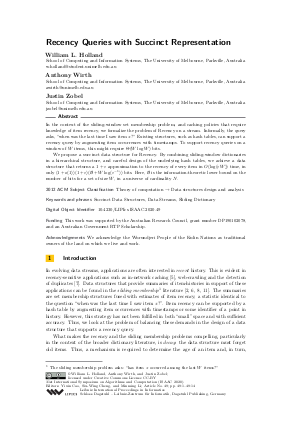Recency Queries with Succinct Representation
Authors William L. Holland, Anthony Wirth, Justin Zobel
-
Part of:
Volume:
31st International Symposium on Algorithms and Computation (ISAAC 2020)
Part of: Series: Leibniz International Proceedings in Informatics (LIPIcs)
Part of: Conference: International Symposium on Algorithms and Computation (ISAAC) - License:
 Creative Commons Attribution 3.0 Unported license
Creative Commons Attribution 3.0 Unported license
- Publication Date: 2020-12-04
File

PDF
LIPIcs.ISAAC.2020.49.pdf
- Filesize: 0.53 MB
- 14 pages
Document Identifiers
Subject Classification
ACM Subject Classification
- Theory of computation → Data structures design and analysis
Keywords
- Succinct Data Structures
- Data Streams
- Sliding Dictionary
Metrics
- Access Statistics
-
Total Accesses (updated on a weekly basis)
0Document
0Metadata
Abstract
In the context of the sliding-window set membership problem, and caching policies that require knowledge of item recency, we formalize the problem of Recency on a stream. Informally, the query asks, "when was the last time I saw item x?" Existing structures, such as hash tables, can support a recency query by augmenting item occurrences with timestamps. To support recency queries on a window of W items, this might require Θ(W log W) bits. We propose a succinct data structure for Recency. By combining sliding-window dictionaries in a hierarchical structure, and careful design of the underlying hash tables, we achieve a data structure that returns a 1+ε approximation to the recency of every item in O(log(ε W)) time, in only (1+o(1))(1+ε)(ℬ+Wlog(ε^(-1))) bits. Here, ℬ is the information-theoretic lower bound on the number of bits for a set of size W, in a universe of cardinality N.
Cite As Get BibTex
William L. Holland, Anthony Wirth, and Justin Zobel. Recency Queries with Succinct Representation. In 31st International Symposium on Algorithms and Computation (ISAAC 2020). Leibniz International Proceedings in Informatics (LIPIcs), Volume 181, pp. 49:1-49:14, Schloss Dagstuhl – Leibniz-Zentrum für Informatik (2020)
https://doi.org/10.4230/LIPIcs.ISAAC.2020.49
BibTex
@InProceedings{holland_et_al:LIPIcs.ISAAC.2020.49,
author = {Holland, William L. and Wirth, Anthony and Zobel, Justin},
title = {{Recency Queries with Succinct Representation}},
booktitle = {31st International Symposium on Algorithms and Computation (ISAAC 2020)},
pages = {49:1--49:14},
series = {Leibniz International Proceedings in Informatics (LIPIcs)},
ISBN = {978-3-95977-173-3},
ISSN = {1868-8969},
year = {2020},
volume = {181},
editor = {Cao, Yixin and Cheng, Siu-Wing and Li, Minming},
publisher = {Schloss Dagstuhl -- Leibniz-Zentrum f{\"u}r Informatik},
address = {Dagstuhl, Germany},
URL = {https://drops.dagstuhl.de/entities/document/10.4230/LIPIcs.ISAAC.2020.49},
URN = {urn:nbn:de:0030-drops-133931},
doi = {10.4230/LIPIcs.ISAAC.2020.49},
annote = {Keywords: Succinct Data Structures, Data Streams, Sliding Dictionary}
}
Author Details
- School of Computing and Information Systems, The University of Melbourne, Parkville, Australia
- School of Computing and Information Systems, The University of Melbourne, Parkville, Australia
Funding
This work was supported by the Australian Research Council, grant number DP190102078, and an Australian Government RTP Scholarship.
Acknowledgements
We acknowledge the Wurundjeri People of the Kulin Nations as traditional owners of the land on which we live and work.
References
-
Yuriy Arbitman, Moni Naor, and Gil Segev. Backyard cuckoo hashing: Constant worst-case operations with a succinct representation. In FOCS, pages 787-796, 2010.

-
Eran Assaf, Ran Ben Basat, Gil Einziger, and Roy Friedman. Pay for a sliding Bloom filter and get counting, distinct elements, and entropy for free. In INFOCOM, pages 2204-2212, 2018.

-
Samy Chambi, Daniel Lemire, Owen Kaser, and Robert Godin. Better bitmap performance with roaring bitmaps. Software: Practice and Experience, 46(5):709-719, 2016.

-
Martin Dietzfelbinger, Anna Karlin, Kurt Mehlhorn, Friedhelm Meyer Auf Der Heide, Hans Rohnert, and Robert E Tarjan. Dynamic perfect hashing: Upper and lower bounds. SIAM Journal on Computing, 23(4):738-761, 1994.

-
Zhe Li, Gwendal Simon, and Annie Gravey. Caching policies for in-network caching. In ICCCN, pages 1-7, 2012.

-
Yang Liu, Wenji Chen, and Yong Guan. Near-optimal approximate membership query over time-decaying windows. In INFOCOM, pages 1447-1455, 2013.

-
Ahmed Metwally, Divyakant Agrawal, and Amr El Abbadi. Duplicate detection in click streams. In WWW, pages 12-21, 2005.

-
Moni Naor and Eylon Yogev. Tight bounds for sliding Bloom filters. Algorithmica, 73(4):652-672, 2015.

-
Rasmus Pagh and Flemming Friche Rodler. Cuckoo hashing. In ESA, pages 121-133, 2001.

-
Daniel D Sleator and Robert E Tarjan. Amortized efficiency of list update and paging rules. Communications of the ACM, 28(2):202-208, 1985.

-
Jiansheng Wei, Hong Jiang, Ke Zhou, Dan Feng, and Hua Wang. Detecting duplicates over sliding windows with RAM-efficient detached counting Bloom filter arrays. In NAS, pages 382-391, 2011.

